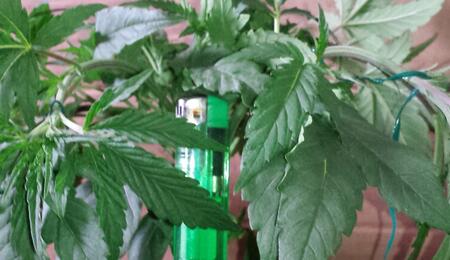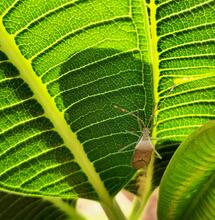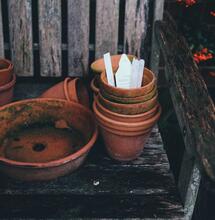Controlling Plant Height

One of the best things about growing your own crops is the option to experiment with growing different varieties, often more flavourful than those found commercially. Genetic variation between different strains of the same species affect most of the variables in the final product including smell, taste, colour and strength of active ingredients. Final size of the plant is also a major factor that is influenced by genetics.
For the average indoor grower, it is often suggested that shorter, stockier varieties are the best ones to go for, usually due to the low vertical height that is a common issue in grow-rooms, what with that big hot light hanging around from the ceiling and all! There are other important factors to consider: tall lanky plants give more shade towards the bottom, thus leading to weak scrawny flowers in the lower half. You can trim off those puny little buds before they have a chance to develop and rob the juicy ones up top of their strength, but then your plant has wasted a lot of energy growing so tall when it could have used that energy to pack out your flowers instead.
So how can we control the height of a plant whose genetics are constantly pushing it to be taller? You may have seen various mysterious bottles of PGR (Plant Growth Regulators) in your local grow shop. These chemicals are synthetic hormones that tinker with the growth structure of the plant, but it is not known if they are safe for consumable crops and personally I would rather not use them on anything I plan to ingest. PGRs are uses extensively in the commercial flower business, but nobody is eating, vaping or smoking carnations! There are several ways to influence height without resorting to chemicals, so let's explore these today instead.
Firstly let's get our environment in order. Growing 101: Plants need lots of light. If you position your grow lamps too high above the plant canopy then you will see stretching happen as the plants race upwards to where the light is strongest. In general your lights should be as close to the tops of the plants as possible without being at all uncomfortable for them – if your hand is cool and comfortable at the level of your plants, then all is well. Be careful not to go the opposite way and have the lights too close, otherwise burning of the plant tops can occur, leaving dead tissue which is unsightly but also an invitation to bugs and mildews.
Temperature of your room is important. Too hot and your plants will stretch. But it's not that simple, as the difference in day and night temperature is also a factor. The wider the difference in temperature, the longer the distance between floral internodes (the length of stem between bud sites). In an ideal world you should be aiming for approximately 4 degrees C difference between your plant's day and night temperatures. If you can get 22 degrees C during the day and 18 degrees C at night, your plant can perform at it's peak.
This seems to be most important to the plant in weeks 2-3 of flowering when the plant is finishing off it's flowering stretch. I've heard of some growers getting extremely short internodes by actually reversing the temperature differential, so the plant is warmer at night. Go easy, 5 degrees C difference is enough. Good air movement around the plants is hugely important for so many reasons, and it also helps keep height down too.
Circulating air fast enough to move the plants during vegetative growth is one of the best things you can do. As soon as the seed sprouts or your clone has rooted and can take a breeze without wilting it should be moving around in the path of an oscillating fan. This strengthens the stem, encouraging lateral growth as opposed to vertical, almost as if the plant “knows” it will be blown over if it gets too tall. Nature is the cleverest grower. Now we have our environment sorted, let's look at some more creative ways we can control our plants height.
Topping
Topping is a classic. This involves pinching out the very newest growing tip, thus stunting the growth up there while the lower branches catch up. This happens due to hormones called Auxins in every actively growing tip. The Auxins restrict lateral growth behind the tip on each branch, so when we pull the growing tip off, the lower shoots can develop without being restricted by the hormonal messages coming from above, and they will all race to become the next lead tip. In time the growth tip you removed will be caught up by the two shoots below it, so you will now have two active growth tips where there was one.
There is a variant of this technique know as “FIM” (“F**k I Missed!”) legend has it that this was discovered by accident, hence the acronym. FIM involves not picking the growing tip off cleanly below the bulbous growth shoot, but a little higher so you actually leave a tiny portion of the growing tip attached. This still restricts the Auxin as usual, but you may find that three or even four new growth tips will appear from the site. Only use this technique during vegetative growth, as the aim is to get the shape correct before you trigger flowering, thus avoiding plant stress at the crucial budding phase.
LST
Low Stress Training (“LST”) is a great technique that can work on its own, or in conjunction with the Topping/FIM described above. You can get super creative with it, and with care make your plant fill whatever space you have. It involves tying the top shoots of your plant down. The bending of the stem restricts the flow of Auxins in the same manner as Topping, thus making the lower shoots race to be the new leading stem. After a week or so you can untie the branches and let the plant carry on unrestricted. You can begin LST on a small plant to get the structure tight from the start, thus ending up with incredibly short bushy plants.
Go slowly, some sturdy branches will need to be tied down a little further every day over the course of 3 or 4 days to prevent snapping. It's also really effective to massage the stem for a few minutes all along the length softening it up and making it more pliable along it's entire length. This spreads out the bend tension across the length as opposed to in one spot which is then prone to snapping. If you do accidentally snap a branch don't stress, you can straighten it back out and use a splint to hold it up. It will be fine, but of course it's still better to bend it carefully to avoid breakages.
You can tie budding branches wherever you need to minimise shading. It's really useful to have a load of hooks, or even some thin wire mesh stapled to your walls to allow for many different potential tie points. Spending the time optimising light penetration to your flowering branches will pay dividends. Often as a plant grows it's useful to reposition some branches a little every couple of weeks to ensure maximum light penetration.
Scrog
This leads us neatly on to Screen Of Green (SCROG) training. You can install a screen a few inches over your plants, then when a branch pops through the top, simply bend it back underneath and allow it to grow horizontally. The growth tip will soon refocus and grow vertically through the screen again, but then you can simply put the little lady back under the screen.
Once the main flowering stretch is finished after approx 2-3 weeks, it's best to allow the buds to grow vertically through the screen, as by this time your plant will already be low and wide with excellent light penetration into the canopy. After trying many different styles of screen, the absolute best material to use in my opinion is the plastic cheap flexible fencing screen that comes of a roll with square holes of around 2 inches. This is ideal because it's flexible but strong enough to hold it's shape.
It is easy to cut with scissors – so if you don't check your grow for a few days and find a rogue branch or two that is growing up through the wrong hole it's easy to just cut the mesh and reposition the branch – something that is a real hassle with metal mesh. Also the wider holed screens are far too wide to allow for precise training.
The two times I used it I found I was supplementing the screen with wire to position my branches more precisely, and the screen actually ended up being more of a hindrance than a help. If you are training your plants with a combination of LST and Topping in veg, then they can slip beautifully into a SCROG setup for flowering, nice and easy.
Personally I suggest FIMing as early as possible (internode 3 on a seed, or equivalent on cuttings) then allowing it to grow vertically for around a week, then starting LST to encourage bushy growth. You may find it prudent to FIM the main tips again once the plant has grown wider, so maximizing the potential carpet of growing tips. Ideally you are looking for a flat wide canopy at the end of vegetative cycle, ready for some explosive flowering! That’s it for now.
Text: Baron Wasteland



.png)